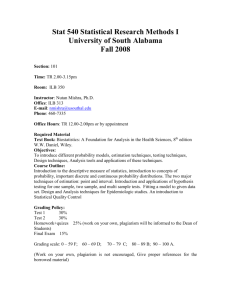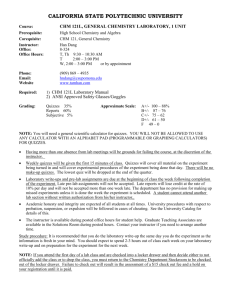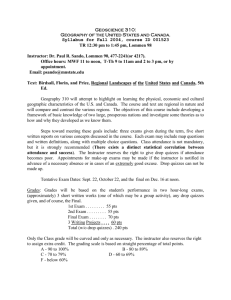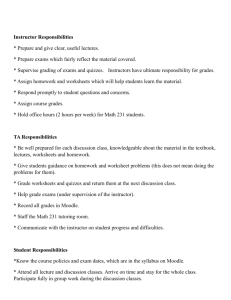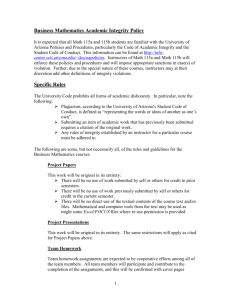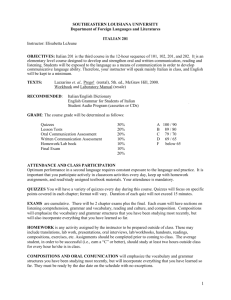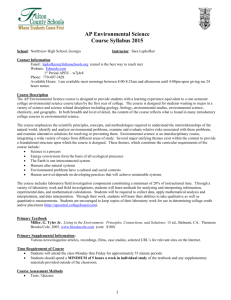Geos 225: Conservation
advertisement
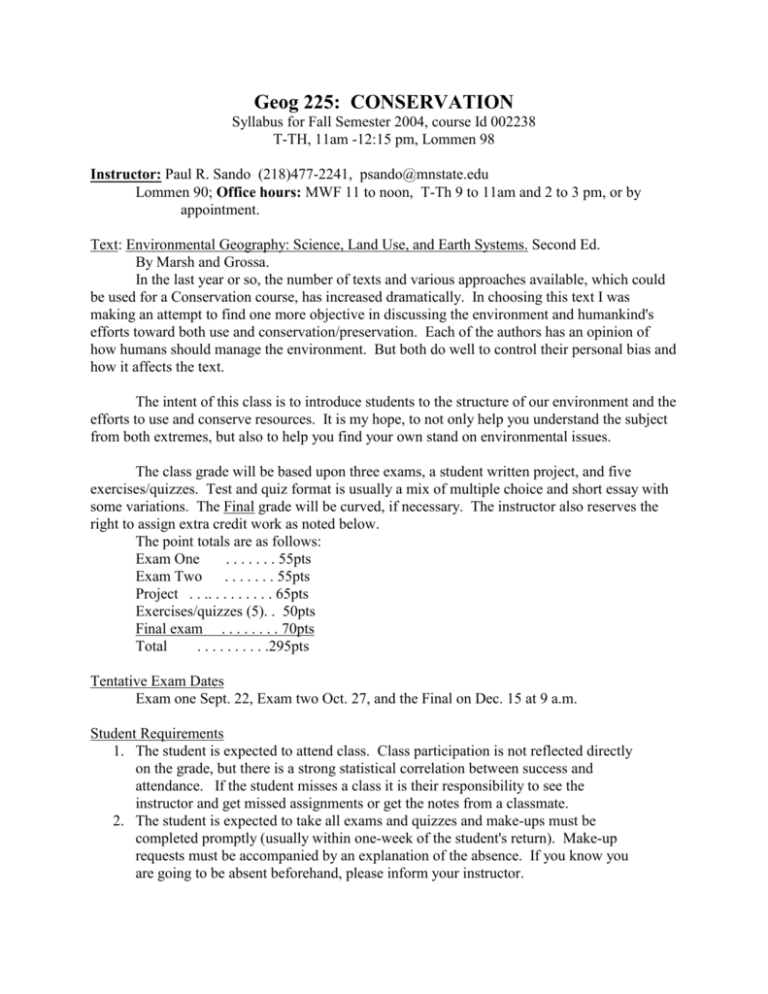
Geog 225: CONSERVATION Syllabus for Fall Semester 2004, course Id 002238 T-TH, 11am -12:15 pm, Lommen 98 Instructor: Paul R. Sando (218)477-2241, psando@mnstate.edu Lommen 90; Office hours: MWF 11 to noon, T-Th 9 to 11am and 2 to 3 pm, or by appointment. Text: Environmental Geography: Science, Land Use, and Earth Systems. Second Ed. By Marsh and Grossa. In the last year or so, the number of texts and various approaches available, which could be used for a Conservation course, has increased dramatically. In choosing this text I was making an attempt to find one more objective in discussing the environment and humankind's efforts toward both use and conservation/preservation. Each of the authors has an opinion of how humans should manage the environment. But both do well to control their personal bias and how it affects the text. The intent of this class is to introduce students to the structure of our environment and the efforts to use and conserve resources. It is my hope, to not only help you understand the subject from both extremes, but also to help you find your own stand on environmental issues. The class grade will be based upon three exams, a student written project, and five exercises/quizzes. Test and quiz format is usually a mix of multiple choice and short essay with some variations. The Final grade will be curved, if necessary. The instructor also reserves the right to assign extra credit work as noted below. The point totals are as follows: Exam One . . . . . . . 55pts Exam Two . . . . . . . 55pts Project . . .. . . . . . . . . 65pts Exercises/quizzes (5). . 50pts Final exam . . . . . . . . 70pts Total . . . . . . . . . .295pts Tentative Exam Dates Exam one Sept. 22, Exam two Oct. 27, and the Final on Dec. 15 at 9 a.m. Student Requirements 1. The student is expected to attend class. Class participation is not reflected directly on the grade, but there is a strong statistical correlation between success and attendance. If the student misses a class it is their responsibility to see the instructor and get missed assignments or get the notes from a classmate. 2. The student is expected to take all exams and quizzes and make-ups must be completed promptly (usually within one-week of the student's return). Make-up requests must be accompanied by an explanation of the absence. If you know you are going to be absent beforehand, please inform your instructor. 3. Exams will includes text material and any material the instructor deems necessary from his lectures and the class discussions. I will review important points and topics in the class time prior to the exam. NOTE:The Final exam is comprehensive. Don't let this frighten you. I will of course place more emphasis on material covered after Exam Two, but the information builds on what we have learned previously. 4. Quizzes will be assigned over material that has been covered in class. We will likely have a taken at least one additional quizzes more than I require for a grade, so the student can expect to drop their lowest score. Quizzes may be either announced or drop quizzes (I am more likely to announce them). NOTES It is impossible to do well in this course without taking decent notes. I do not lecture from the text alone, so it is the student's responsibility to read and make sure they understand the text. 5. Writing Project: The students will be expected to complete one writing project. The project shall consist of at least 8 full pages of double-spaced typed text (in the body of the work), and where appropriate maps and any other relevant tables or graphics. The topic must, of course, focus on Environmental Conservation, and must be approved prior to writing by the instructor. Otherwise, the topic is up to the student's discretion. Instructor's approval is necessary in order to avoid doubling up on a subject, to address or avoid problems early on before the writing begins, and lastly, to allow the student a good chance of finding reference materials. You must have a minimum of five references, but more is definitely better. The text does not count as a source, though you may cite it. HINT: the Web is strongly suggested as a good place to look for sources. It is expected that the student will communicate well and will present a decently edited paper. References should be cited within the text according to any major accepted format (Turabian, MLA, etc.) and should also be listed in a bibliography. Feel free to make use of the Write Site for assistance in completing the paper. The projects are due on or about Nov. 16. 6. Students with disabilities who believe they may need an accommodation in this class are encouraged to contact Greg Toutges, Coordinator of Disability Services at 477-2652 (phone) or 477-2047 (TTY), CMU 222 as soon as possible to ensure that accommodations are implemented in a timely fashion. 7. Lastly, there is an (unfortunately) necessary little reminder. This is a university course, and the students are expected to conduct themselves as proper scholars. The University's policies concerning any academic dishonesty including plagiarism are listed in your student handbook. If you use an author’s ideas, paraphrase, or quote, always, ALWAYS, cite the source in some fashion. The instructor will make every effort to keep the students informed of where they are in the class outline to follow later (I reserve the right to deviate) and what is assigned. The following is a tentative outline of the material to be covered in class: I. Introduction and Ideology of Environmental Usage and Sustained Development (ch 1,2,3) A. The Environment in the 21st Century B. Preparing to understand the Environment 1. Economics and resource use 2. Markets; supply and demand 3. Individual firms or users 4. Big business 5. Issues of ownership C. The Ideology behind the policy 1. historical looks at resource policy 2. Legislation, public opinion, and the political meat grinder D. The big catchphrase: Sustainable Development 1. Human impacts 2. Changes in policies 3. Constraints on what is sustainable II. Environmental systems (Ch. 5 & 6) A. What is an Ecosystem? 1. Systems within systems 2. The environment's immune system 1. Energy systems 2. Matter systems B. Basic Ecosystems 1. Type and Characteristics 2. Patterns and distributions 3. Spatial dynamics 4. Human impacts III. The Effect of Population (Ch 4 & 7) A. The spread and development of Human Population 3. Dispersal and migration 4. Different population environments B. Trends and Patterns 1. Structure of a population 2. Family planning? 3. Future trends IV. Atmospheric systems and Pollution (Ch 10 and 11) A. Composition of the Atmosphere 1. Thermal structure 2. Pressure and circulation 3. Solar radiation B. Heat balance 1. Urban climate 2. Greenhouse effect and World issues C. Pollution 1. Types and sources a. usage of air b. air pollution and quality issues c. Urban pollution d. Impacts of pollution 2. Atmospheric Change a. acid rain b. greenhouse Earth? c. Ozone holes 3. How well are we doing? IV. Hydrologic Environment and Pollution (CH 12 and 13) A. Hydrology, Precipitation and Storms B. Streamflow and flooding C. Groundwater and wetlands D. Human use of water E. Types and methods of water pollutions F. Pollution control and treatments V. Hazardous Waste production and control (Ch 14) A. Waste production B. Waste disposal, problems, and regulation C. Reduction and Recycling VI. Soils and Agriculture (CH 15 and 8) A. Soil properties and formation B. Integration of soils and landuse C. Soil erosion D. Evolution and development of Agriculture E. Food choices F. The geography of hunger G. Agricultural horizons and sustainability VI. Biological Diversity and Land Resources (Ch. 16 and 17) A. Species and genetic diversity B. Endangered, Threatened, and Protected species. C. Open land resources D. Parks and other protected areas. VII. Managing the Global Environment (Ch. 18)


